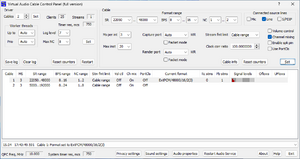Software:Virtual Audio Cable
 | |
 VAC 4.70 Control Panel | |
| Developer(s) | Eugene Muzychenko |
|---|---|
| Initial release | 14 October 1998 |
| Stable release | 4.70
/ 16 April 2023 |
| Written in | C++ |
| Operating system | Microsoft Windows |
| Available in | English |
| Type | Audio software |
| License | Shareware, Freeware (feature-limited) |
| Website | vac.muzychenko.net |
Virtual Audio Cable is a software product based on WDM multimedia driver that allows a user to transfer audio streams from one application to another. Any application is able to send an audio stream to the input side of a "virtual cable" while a corresponding application can receive this stream from the output side. Since all transfers are made digitally, there is no loss in sound quality. VAC is the audio equivalent of a MIDI loopback device such as MultiMid or Hubi, and can be used instead of "Stereo Mix" or "What U Hear" features of audio adapters.[1][2]
If more than one application is sending audio through an output virtual cable, VAC is able to mix all of the streams together or create separate corresponding virtual input cables. Similarly, more than one application is able to receive audio from an input cable, whether it's sharing the same audio data with another target or receiving its own personal audio stream.[3] VAC is useful for recording an application's audio output in almost real time or transferring a sound stream to another application so it may process it. A person could use two or more software audio generators, synthesizers or sequencers to produce audio streams and send them to a VAC output cable and record the mixed stream from the VAC input cable using any type of recording software.
Because VAC routes audio streams in almost real time, it is able to be utilized in various manners. A person is capable of using VAC to record an output audio stream from an application that normally does not allow saving the audio to files.[4] Practically, the input port records the audio signal (for example from a music player) and sends it to the destination program (such as a sound processor or analyzer) using the output port.[5] A user could also manipulate VAC into recording conversations through Voice Over IP (VoIP)[6] or Internet telephony applications such as Skype[7][8] (for example, with SAM Broadcaster[9]), produce live audio podcasts,[10] redirect audio channels to multiple monitors,[11] or even decode weather faxes.[12]
Features
- Windows XP/2003/Vista/7/8/8.1/10/11 platforms (x86, x64 and arm64)
- Native WDM/KS audio technology
- Up 256 Virtual Cables (Windows limits the number of Multimedia Extensions devices to 32)
- 1..20 milliseconds per timer event (formerly interrupt)
- 1..100 pin instances
- Supports almost any of fixed point PCM audio formats (Floating point formats are not supported)
- Low sound latency with maximal interrupt frequency (1000 Hz, 1 ms period).
- Unlimited number of Kernel Streaming clients connected to each port
- RT Audio (WaveRT) protocol support with notification events, packet mode, clock and position registers. Clock registers are bound to Virtual Cables so all streams in each cable are coherent.
- Signal mixing between output port clients
- PCM format conversion
- Volume control features
- Clock correction features to reduce or totally eliminate clock rate difference effects
- Channel scattering/gathering mode
- Control Panel application to dynamically configure cables
References
- ↑ Steven Helstrip (May 1999). "Create a good compression" (in en). Personal Computer World (PCW) (5): 269. ISSN 0142-0232. https://archive.org/stream/PersonalComputerWorldMagazine/PCW%20199905%20May%20Created%20From%20PCW%20Cover%20CD#page/n153.
- ↑ "How to FIX Crippled Stereo Mix on a Laptop". Bright Hub. 2010-09-06. https://www.brighthub.com/computing/windows-platform/articles/19005.aspx.
- ↑ VAC UK, software-dungeon.co.uk. Retrieved August 2011
- ↑ Tobias Hauser, Christian Wenz (2003). "DRM Under Attack: Weaknesses in Existing Systems" (in en). Digital Rights Management: Technological, Economic, Legal and Political Aspects. Lecture Notes in Computer Science. 2770. Springer Science+Business Media. p. 214. ISBN 9783540450382. https://books.google.com/books?id=QKmoCAAAQBAJ&pg=PA214.
- ↑ "Virtual Audio Cable 4.60 Free Trial - Connect several audio applications together in real time...". Softpedia. 2014-06-05. http://www.softpedia.com/get/Multimedia/Audio/Other-AUDIO-Tools/Virtual-Audio-Cable.shtml.
- ↑ Lingfen Sun; Is-Haka Mkwawa; Emmanuel Jammeh; Emmanuel Ifeachor (2013). "8.3.2. Virtual Audio Cable injection tool" (in en). Guide to Voice and Video over IP: For Fixed and Mobile Networks. Springer Science+Business Media. pp. 202–204. ISBN 9781447149057. https://books.google.com/books?id=4VlIAAAAQBAJ&pg=PA202.
- ↑ Ryo Yoshida; Michiaki Yasumura (July 9–11, 2008). "A New Cell Phone Remote Control for People with Visual Impairment" (in en). 11th International Conference, ICCHP 2008. Linz, Austria: Springer Science+Business Media. p. 1148. ISBN 9783540705390. https://books.google.com/books?id=LokAvXdx5X0C&pg=PA1148.
- ↑ Michael Gough (2005). "7. Software Add-ons for Skype" (in en). Skype me! : from single user to small enterprise and beyond. Elsevier. p. 218. ISBN 9780080489711. https://books.google.com/books?id=9sAg-5iJtkQC&pg=PA218.
- ↑ "Using Virtual Audio Cables to Integrate SAM Broadcaster with Skype". Spacial. 2018-03-22. https://spacial.com/using-virtual-audio-cables-integrate-sam-broadcaster-skype/.
- ↑ "How to Produce a Live Audio Podcast". Barnesian. 2011-10-04. https://barnesian.com/how-to-produce-a-live-audio-podcast/.
- ↑ "How to redirect same audio channel on all screens using Virtual Audio Cable". MonitorsAnyWhere. http://new.monitorsanywhere.com/how-to-redirect-same-audio-channel-using-virtual-audio-cable/.
- ↑ "Decoding Multiple Weather Faxes at a Time". HF Radio Review. 2015-10-26. http://hfradioreview.com/index.php/tag/virtual-audio-cable/.
External links
 |

